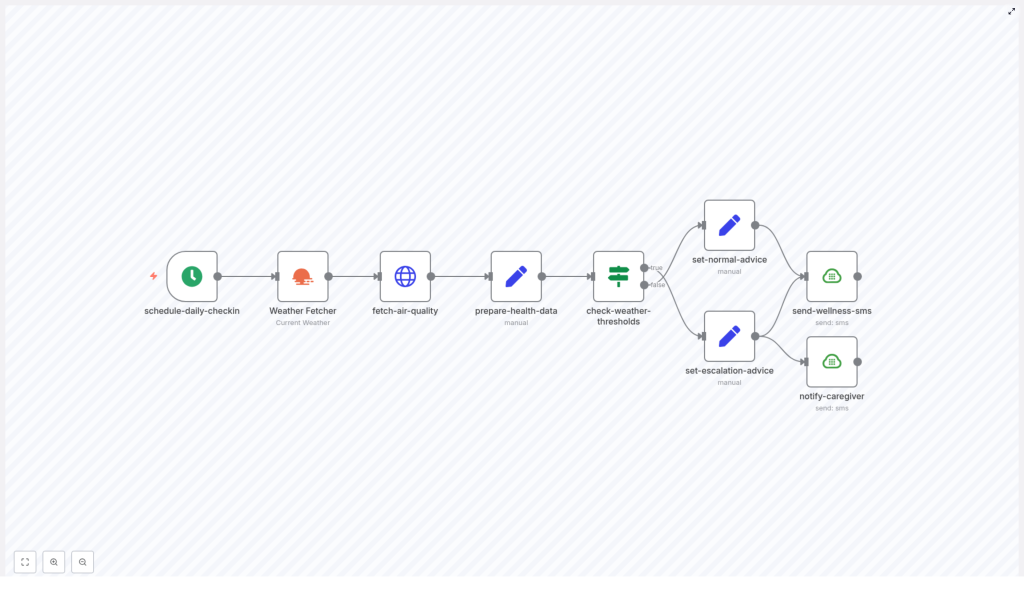Elderly Care Automation: Daily Wellness & Weather Alerts
Keeping older adults safe and comfortable requires timely information and quick caregiver action. This guide explains a practical automation workflow—built with n8n—that performs a daily wellness check for elderly people by combining weather, air quality, and automated SMS alerts for caregivers. Use this to reduce risk, improve response times, and add consistent daily check-ins into your care routine.
Why automate daily wellness and weather alerts?
Elderly adults are more vulnerable to extreme temperatures, high winds, and poor air quality. Manual monitoring can be inconsistent. An automated daily wellness and weather alert system provides:
- Consistent daily checks at a scheduled time (for example, 8:00 AM).
- Actionable advice for the older adult (stay hydrated, avoid outdoor activity, etc.).
- Escalation to caregivers via SMS when thresholds are exceeded.
- Integration with weather and air quality APIs for real-time context.
Overview of the workflow
The workflow you see in the template performs the following steps:
- Schedule a daily trigger (cron) at 08:00 to start the check-in.
- Fetch current weather for the recipient’s city (OpenWeatherMap).
- Fetch air quality index (AQI) using OpenWeatherMap’s air pollution endpoint.
- Prepare health-relevant data (temperature, feels-like, wind speed, humidity, AQI).
- Evaluate thresholds (very low/high temperature, high winds, extreme heat).
- Send a normal daily wellness SMS when conditions are safe.
- Send escalation SMS to the caregiver and a more urgent SMS to the recipient when extreme conditions are detected.
Step-by-step node breakdown
1. schedule-daily-checkin (Cron)
Set a cron node to trigger the workflow at a consistent time each day—recommended 08:00. This ensures recipients receive advice early enough to adjust plans (e.g., avoid afternoon heat).
2. Weather Fetcher (OpenWeatherMap)
Call the OpenWeatherMap API to get current weather data. You can set cityName dynamically per recipient (the template uses a default like Miami). Store these values for later use: main.temp, main.feels_like, wind.speed, and main.humidity.
3. fetch-air-quality (HTTP Request)
Use the OpenWeatherMap air pollution endpoint to retrieve AQI. Combine AQI with weather to give more nuanced advice—for example, on unhealthy AQI days, advise staying indoors even if the temperature is comfortable.
4. prepare-health-data (Set)
Normalize the data into fields such as temperature, feelsLike, windSpeed, humidity, and airQualityIndex. This makes evaluation and templating simpler downstream.
5. check-weather-thresholds (If)
Define your threshold rules here. The template uses common caregiver-focused thresholds, for example:
- temp < 0°C (hypothermia risk)
- temp > 32°C (heat stress risk)
- feelsLike > 38°C (extreme heat)
- windSpeed > 15 m/s (dangerous high winds)
- AQI levels can also trigger escalation (e.g., AQI > 150)
6. set-normal-advice & set-escalation-advice (Set)
Based on the condition outcome, set a friendly message for the recipient and an escalated flag for the caregiver. Keep messages concise and action-oriented (for example: “Stay hydrated and avoid outdoor activity today.”)
7. send-wellness-sms & notify-caregiver (Plivo SMS)
Use an SMS provider like Plivo to deliver messages. The template sends two types of SMS: a routine wellness message to the recipient and an escalation alert to the caregiver when conditions are dangerous.
Practical tips for configuration
- API Keys: Store OpenWeatherMap and Plivo credentials securely in n8n credentials. Never hard-code keys in a public workflow.
- Local units: Confirm units for temperature (Celsius vs Fahrenheit) and convert if needed depending on the recipient’s location.
- Dynamic recipients: Use a database or Google Sheet to load recipientCity, recipientPhone, and caregiverPhone dynamically for multiple recipients.
- AQI handling: Map AQI numeric values to human-friendly categories (Good, Moderate, Unhealthy) for clearer messages.
- Testing: Use a staging phone number and a test city to confirm messaging and threshold logic before going live.
Safety, privacy, and compliance
When automating healthcare-related communication, protect personal data and follow relevant regulations (HIPAA, GDPR) as applicable. Key steps:
- Limit stored personal data to what’s necessary for the workflow (phone number, location).
- Use encrypted credentials for APIs and secure storage for recipient records.
- Get explicit consent from the older adult (or authorized representative) to receive automated messages.
How to scale and extend this workflow
To support multiple recipients or richer logic:
- Loop over a recipients list (database or spreadsheet) and run the weather/AQI check per person.
- Record a daily log of checks to a database for audit and trend analysis.
- Add a voice call notification or mobile push notification for urgent escalations.
- Integrate wearable data (if available) for personalized thresholds (e.g., heart rate alerts combined with heat warnings).
Common pitfalls and troubleshooting
- Incorrect timezone in cron: confirm server timezone matches expected schedule.
- API rate limits: use caching or stagger checks to avoid exceeding provider limits.
- Message templates too long: SMS length affects cost and readability—keep messages short and actionable.
- False positives: tune thresholds and test with historical weather data to reduce unnecessary escalations.
Real-world use cases
This workflow is useful for:
- Home care agencies that want daily automated wellness checks.
- Family caregivers caring for remote older relatives.
- Senior living communities that need an automated monitoring layer for environmental risks.
Get started — checklist
- Create accounts: n8n, OpenWeatherMap, Plivo (or alternative SMS provider).
- Secure API keys and add them to n8n credentials.
- Customize thresholds and messaging for your population.
- Test the workflow with a few recipients and adjust rules.
- Launch and monitor for the first two weeks to fine-tune escalations.
Conclusion & call-to-action
An automated daily wellness and weather alert workflow reduces risk and enhances caregiver responsiveness. Start by cloning the template, configuring your API keys and recipients, and testing carefully. If you’d like help customizing thresholds, integrating a database of recipients, or adding push/voice alerts, contact our team to get a tailored setup.
Ready to protect your loved ones with automation? Clone the workflow, test with a safe number, and reach out for a free consultation to customize this system for your care program.

